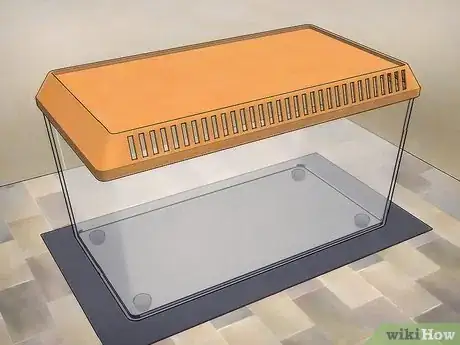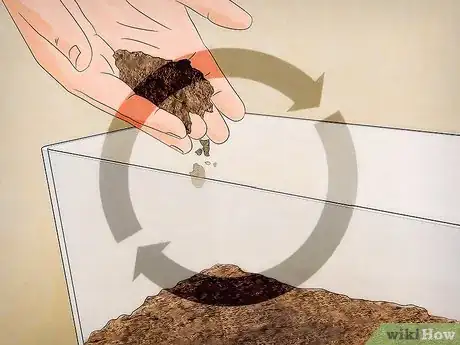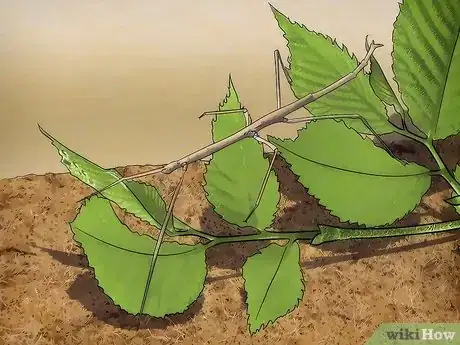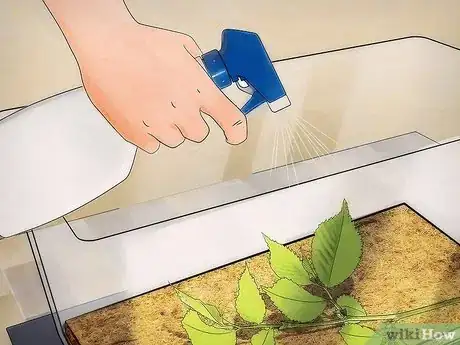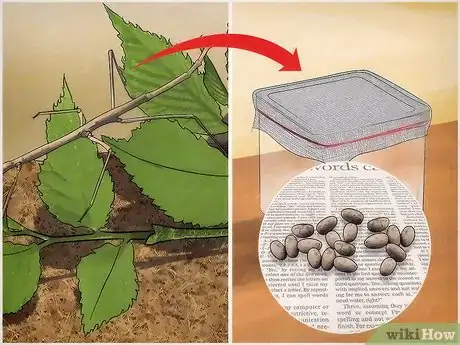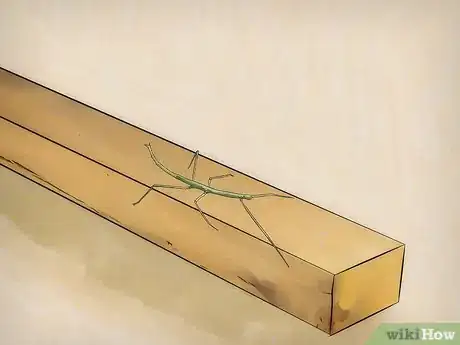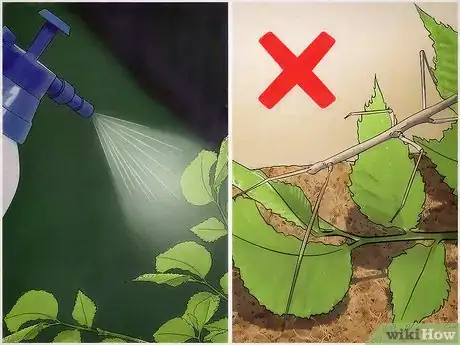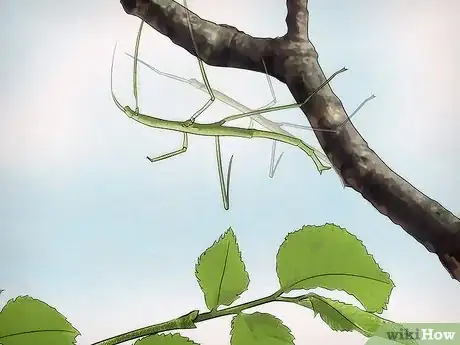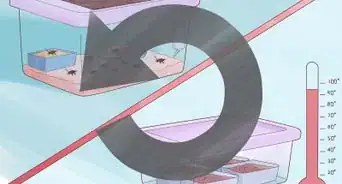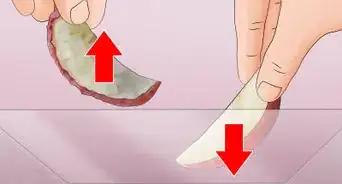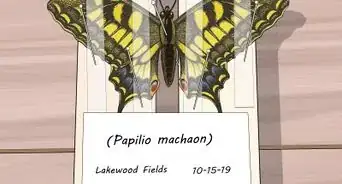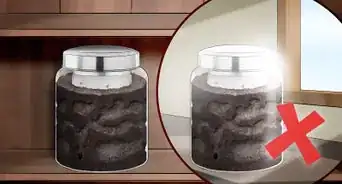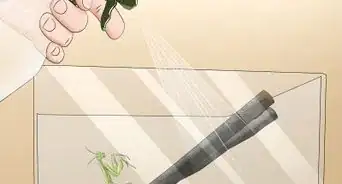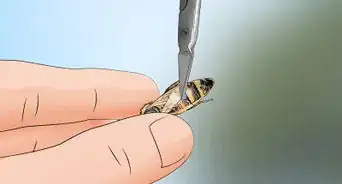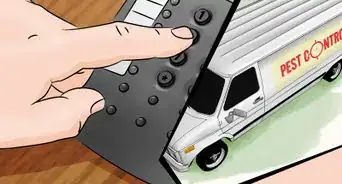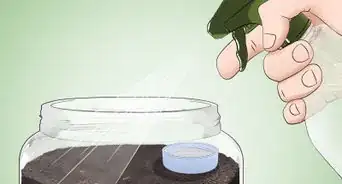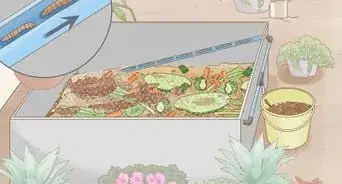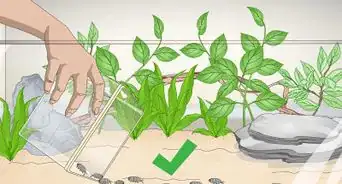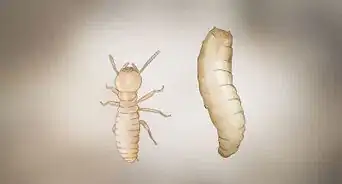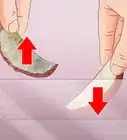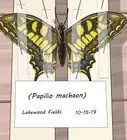This article was co-authored by Pippa Elliott, MRCVS. Dr. Elliott, BVMS, MRCVS is a veterinarian with over 30 years of experience in veterinary surgery and companion animal practice. She graduated from the University of Glasgow in 1987 with a degree in veterinary medicine and surgery. She has worked at the same animal clinic in her hometown for over 20 years.
wikiHow marks an article as reader-approved once it receives enough positive feedback. This article received 14 testimonials and 88% of readers who voted found it helpful, earning it our reader-approved status.
This article has been viewed 106,905 times.
Stick bugs are long insects that resemble sticks. They can be purchased at many pet stores around the world. If you have purchased a stick insect, you should make sure you care for it properly. Make sure you provide a safe environment for your insect. Choose quality food and handle your stick insect with care. In the event your stick insect lays eggs, make sure you know how to properly care for its babies.
Steps
Creating the Proper Environment
-
1Provide an appropriate habitat for your stick insects. Height is important when it comes to a stick insect housing, as some stick insects are long and enjoy climbing.
- Your stick insects home should be about three times as high as the total length of your stick insect. If your stick insect is still growing, look up about how big your breed of stick insect tends to grow.
- You should get a glass habitat with a mesh lid. Make sure to get a mesh lid as this provides necessary ventilation for your stick insect.
-
2Cover the floor with a moisture absorbing substance. You'll need some substrate, which is the material that coats the bottom of an insect's cage. You should cover the floor with a moisture absorbing substrate. Potting soil or pebbles would work well.[1]Advertisement
-
3Provide resting places and some safe decorative items or enrichment. Enrichment is anything that enriches your pets environment, anything that make its habitat more like it's natural environment. Stick insects love to climb and will be unhappy if they can't be active in their cages. Provide a variety of climb-able decorations, as well as resting places. You can look for these kinds of supplies at a local pet store.
- You can look for plastic sticks, as long as they don't use too many chemicals, at a local pet store. Try to find sticks with a large circumference, so your stick insect can rest on the top of the stick when it finishes climbing.
- You can collect branches outside, as well as plants, for your stick insects to climb. You can also purchase plants from the store for your stick insect's cage. Keep in mind plants will definitely be eaten, however. Also, remember if you search for food locally make sure you check each leaf carefully. Many stick bugs have died from a spider that somehow got inside on a plant. Make sure any plants you provide are pesticide-free, as pesticides can potentially harm stick insects.
-
4Clean your stick insects home regularly. Stick insects will leave droppings in their cage, and will shed their skin. It's a good idea to periodically remove droppings and skin when the cage looks dirty.
- You may want to periodically replace your substrate as well, which means you'll have to temporarily transfer your stick insects to another container.
Providing Basic Care
-
1Pick the proper food for your stick insect. Stick insects should only be fed plants. The type of plants you should provide depends on your type of stick insect. Many will eat oak leaves, vines and berries. Make sure you give your type of stick insect the food it needs. All leaves should be fresh. If you feed them leaves, remember to spritz the enclosure so they do not become dehydrated. Do not put a water dish in the cage if you also have baby stick bugs, or they will drown.
- The majority of the commonest stick insects can get by eating bramble leaves or holly. You should be able to find leaves at a local pet store. You can also purchase them online. If you choose to collect leaves locally, only do so in places where leaves have not been treated chemically. Chemicals and pesticides can be deadly for stick insects.
- Indian stick insects have a slightly different diet and may not take well to bramble leaves. Oak, rose, and hawthorn are the primary leaves eaten by Indian stick insects. As with bramble leaves, you can purchase these online or at a pet store. If you plan to collect locally, only do so in an area free of pesticides.
- Place leaves in a glass jar for your stick insects. Replace the leaves as the stick insects eat them. If you notice any leaves are getting old or rotten, remove them.
-
2Keep your stick insect in a warm environment. Stick insects typically live in tropical areas, so it's vital you keep your stick insect's cage warm. Temperature's less than 59 °F (15 °C) can be harmful.
- Generally, the temperature should be around 68 °F (20 °C), which is a normal room temperature. As long as there is no draft, your stick insects should be safe in your home most of the time.
- Indian stick insects may need slightly cooler temperatures to thrive. They may be better off at 65 degrees Fahrenheit, so move them to a cooler room if necessary.
-
3Spritz plants regularly to provide water. It's a bad idea to have a water bowl in a stick insects cage as they could fall in and drown. Stick insects can usually drink water droplets found on plants. Get a spray bottle and mist the plants in your stick insect's cage each day to ensure they get enough water.
-
4Handle your stick insect with care. You may want to play with your stick insect, which can be a fun and safe way to bond with your pet. However, always handle stick insects with care to avoid stressing them out.
- Stick insects are extremely delicate, so handle them very gently. When taking your stick insect out of its cage, lift it from its body and not its legs. Its legs could break off if you attempt to pick your stick insect up by the legs.
- Allow your stick insect to walk on your fingers and into the palm of your hand. When you put your stick insect back in the cage, make sure you do so gently. Go slowly to avoid startling your stick insect. You do not want to accidentally catch one of its legs if it starts squirming.
Dealing with Special Circumstances
-
1Take care of stick insect eggs. If you have more than one stick insect, they may end up breeding. If your stick insect lays eggs, make sure you care for the eggs properly.[2]
- If you see eggs in your stick insects cage, gently transfer them to a shallow container with a lid. Punch small holes in the lid to allow for air flow. Line the bottom of the lid with newspaper or sand.
- You can safely store the eggs at room temperature, but keep in mind not all eggs will survive. Stick insects lay many eggs as a lot of eggs do not end up hatching. Lightly spray the eggs with water once a week.
-
2Make sure you care for baby stick insects properly. Once the stick insects hatch, you can return them to the main cage. Stick insects do not have a larval stage, so they will emerge as full-bodied insects. Make sure you provide plenty of leaves as soon as the eggs hatch. If you want to handle the babies, do so with an object like a pencil or paintbrush. Your hands may be too big to pick up babies safely.[3]
-
3Prevent any factors that could cause poor health. With proper care, stick insects are usually fairly healthy. There are several things you can do to assure your stick insects live long, healthy lives.
- Stick insects sometimes get fungus on their skin. Wash this away with a rag dabbed in water. Fungus can spread to a stick insect's internal organs, causing death.
- Spritz the cage regularly so your stick insects have access to water. Wash any leaves you feed your stick insect thoroughly and avoid leaves treated with chemicals and pesticides.
-
4Do not be alarmed by deformities accrued during shedding. Occasionally, stick insects will develop deformities during shedding. A stick insect's leg may be bent at an odd angle. While this can look alarming, this does not generally affect a stick insect's health.
- To help prevent such abnormalities, make sure your cage is high enough. Stick insects often hang upside down when they shed. If a cage is too small, a stick insect may not have adequate room for shedding, causing deformities.
References
About This Article
To take care of a stick bug, keep it in a ventilated glass container that's at least 3 times taller than the length of your stick bug's body. You should also line the bottom of the container with potting soil or pebbles, and add sticks, branches, and plants for your stick bug to climb on. To feed your stick bug, make sure it always has access to fresh leaves that it would normally eat in the wild, like bramble leaves or holly. Also, spritz the inside of its container with water regularly so it doesn't get dehydrated. For more tips from our Veterinary co-author, like how to handle your stick bug, scroll down!
